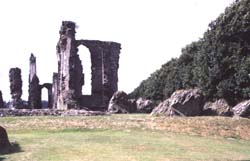 |
 |
 |
 |
 |
 |
 |
|
|
Cistercian Abbeys: NEATH Name: NEATH Location: West of
the River Neath County: West Glamorgan In 1129 Richard de Granville granted his fee, situated on the west bank of the river Neath, to the Norman abbey of Holy Trinity at Savigny for the foundation of a new monastery. A year later Abbot Richard (d. 1145) and his twelve monks arrived from Savigny and a new community at Neath was formed: it was the second daughter-house of Savigny in England and Wales. The monks soon found that their lands were far too scattered to be managed properly and during the 1190s a plan was put forward for the monastery to move to the site of its property at Exford in Somerset. The plan was thwarted when, in 1198, the abbey of Cleeve was established barely ten miles from the site at Exford. Thus, instead of moving, the community decided to put its efforts into consolidating its lands closer to home. This eventually paid off and by the end of the thirteenth century Neath Abbey was one of the wealthiest houses in Wales.(1) The numbers increased and after the house was burnt down in 1224 by Morgan ap Owen it appears to have been entirely rebuilt for twenty-four monks and forty to fifty lay-brothers.(2) Between 1280 and 1320 the twelfth-century Romanesque church was replaced by a new Gothic construction. The scheme attracted the attention of King Edward I and, on a visit to Neath in 1284, he presented the abbey with a beautiful canopy, intended for the High Altar.(3) After the death of Gilbert de Clare in 1314
rebellion broke out in Glamorgan. The monks of Neath were ‘plundered
of their goods by reason of rebellion of certain Welshmen . .
.
and their house devastated and ruined’.(4) Neath
experienced further financial difficulties during the fifteenth
century but it seems that by around
1500 the house had largely recovered from these set
backs. During the beginning of the sixteenth century, the southern
end of
the dormitory and the refectory ranges were adapted to provide
the abbot with substantial private accommodation. From about 1509
until
the Dissolution these new apartments were occupied by Abbot Leyshon
Thomas, the most influential Cistercian abbot of late medieval
Wales.(5) Despite having
a fine reputation, Neath Abbey had an annual net income of just £132
at the time of the Dissolution and thus should have fallen under
the first Act of Suppression in 1536.
In
order to avoid closure, Abbot Leyshan paid the heavy fine of £150.
However, the house evaded suppression for only three years, and
was finally dissolved with the larger monasteries in 1539. A few
years later Cromwell (d. 1545) purchased the site and converted
parts of the monastic buildings into an impressive Tudor mansion.
These buildings were to be abandoned in the early years of the
eighteenth
century and left to ruin. Today the remains include much of the
east and west ranges of the monastic buildings, the gothic church
and the mansion. The site is now under the care of Welsh Historic
Monuments and is open to the public at all reasonable times. It
has recently been suggested that the ‘Red
Book of Hergest’, one of the ‘Four Ancient Books of
Wales’,
normally ascribed to Strata Florida,
was in fact copied in a Glamorgan monastery – probably Neath.(6)
|
